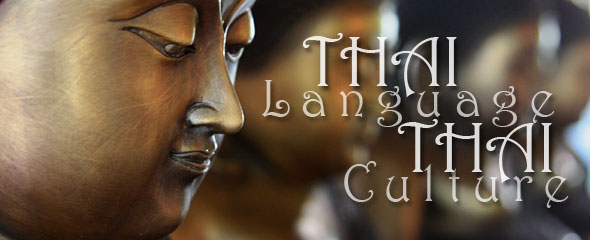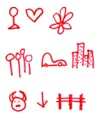
This article was originally posted on WomenLearnThai.com.
"*" indicates required fields
Thai Language Thai Culture: Language as Symbols…
We start with an idea in our heads. In order to get this idea into another person’s head we use the magic of language. When we use language we turn the idea in our heads into a symbol, a symbolic noise that our mouths make that we usually call “words”. The other person catches these “words” with their ears at which point their brains interpret them. If they are using the same set of audio symbols as we use (i.e. the same language) then the idea which was in our heads, or at least an approximation of it, is now in the listening person’s head. I have always thought that was pretty magical.
With this idea of language being symbols I wanted to try and use symbols in teaching my English conversation classes at Chiang Mai University. It worked quite well and I later turned the idea into a formal paper that was presented at the 1980 International TESOL Convention called “Symbol Stories”.
When the questions recently started coming up on the Facebook group “Farang Learn Thai” about developing fluency in Thai I thought about how using symbols is a great way to practice getting an idea from our heads, using vocabulary and grammar we already know, and turning it into a fluent utterance.
The following are a few examples of how a teacher of Thai, or even someone learning Thai on their own, can use symbols to help create complete sentences from ideas that are in the learners’ heads.
There will be no “listen and repeat” here and no grammar lessons. All the language that you will be creating will come from your own heads. This will be just a way to put stuff you already know into fluently spoken words and sentences.
The symbol stories method is not used to teach new vocabulary (although you may look stuff up that you would like to say) nor is it for teaching grammar, word order, or sentence structure. That should be done with a teacher and/or in a classroom. Symbols will allow you to combine all the stuff you already know and help you to put it all together into fluent coherent Thai.
Note that this method can be used with learners at any level, whether you have a vocabulary of only a few dozen words, or you are an advanced learner.
Defining our symbols…
Let’s start with the symbol below.

I’ll ask you to give me a word (in reality an audio symbol) for what you see. In this case, the symbol looks like a person to me. People words are nouns. Since we are talking about the Thai language, all the nouns we come up with should be in Thai.
Look at the symbol and think of a Thai word (not a word in your native language). This should get you started thinking in the target language.
I’ll start with some Thai words that I think of when I see the above symbol.
คน /kon/ – person
ผู้ชาย /pûu-chaai/ – man, boy
ผู้หญิง /pôo yĭng/ – woman, girl
ฉัน /chăn/ – I
ดิฉัน /dì-chăn/ – I
ผม /pŏm/ – I
Then we can get fancier.
มนุษย์ /má-nút/ – human
ครู /kruu/ – teacher
ตำรวจ /dtam-rùuat/ – policeman
คุณพ่อ /kun-pôr/ – father
คุณแม่ /kun-mâe/ – mother
And of course the symbol below could be the plural of all the above.

เพื่อน /pêuan/ – friend, friends
นักเรียน /nák-rian/ – student, students
At this point the learner can come up with more words depending on his/her Thai vocabulary. If you have an idea in your head, and you know the Thai word for it, then it will work.
If you have an idea and don’t know the Thai word for it, use that magic of a dictionary to find one that works for you. For instance, you have the idea that the symbol represents “President Obama”. This will be a great opportunity to add the word “president” to your vocabulary in a meaningful way.
ประธานาธิบดี Obama /bprà-taa-naa-tí-bor-dee Obama/ – President Obama
 Now that we have a noun, let’s try adding a verb.
Now that we have a noun, let’s try adding a verb.
What comes into your mind seeing this symbol? Here are a few I think of.
ไป /bpai/ – go
เดิน (ไป) /dern (bpai)/ – walk
วิ่ง (ไป) /wîng (bpai)/ – run
เดินทาง (ไป) /dern-taang (bpai) / – travelled (to)
กลับ (จาก) /glàp (jàak)/ – return (from)
Turning symbols for verbs into Thai is easier than with other languages since we don’t need to worry about tense or person.
Tense:
ไป /bpai/ – go, went, will go, has gone
Person:
ไป /bpai/ – go, goes, has gone, have gone
I am sure you can come up with some more.
Now for a destination symbol.

What do you see? Here is what I see.
บ้าน /bâan/ – house, home
โรงเรียน /rohng-rian/ – school
ตลาด /dtà-làat/ – market
Or something more fancy.
บ้านเพื่อน /bâan pêuan / – my friend’s house
ตลาดนัด /dtà-làat nát/ – farmers’ market
ทำเนียบขาว /tam-nîap kăao/ – The White House
Forming Sentences…
 Now let’s put this together into a more complete idea. Look at the symbols below and tell me in Thai what ideas come into your head. Use the symbol meanings we have listed above to build your Thai sentence. Then try some new ideas from symbol meanings that you come up with on your own.
Now let’s put this together into a more complete idea. Look at the symbols below and tell me in Thai what ideas come into your head. Use the symbol meanings we have listed above to build your Thai sentence. Then try some new ideas from symbol meanings that you come up with on your own.
Here are a few examples using the above Thai words.
คน ไป ตลาด
kon bpai dtà-làat
The person went to the market.
ครู วิ่งไป บ้านเพื่อน
kroo wing bpai bâan pêuan
The teacher ran to her friend’s house.
ประธานาธิบดี Obama เดินทางไป ทำเนียบขาว
/bprà-taa-naa-tí-bor-dee Obama dern taang bpai tam-nîap kăao/
President Obama travelled to the White House.
And depending on your level of Thai you can expand the sentences.
ผม กลับ บ้าน
pŏm glàp bâan
I returned home.
ผม จะ กลับ บ้าน
pŏm jà glàp bâan
I will return home.
ผม กลับ บ้าน แล้ว
pŏm glàp bâan láew
I have already returned home.
Asking Questions…
 Most of our time spent studying a language is used making statements. Less time is usually spent in learning to ask questions. If we look at a statement as basically an answer to a question then we can use our symbols to help us produce questions.
Most of our time spent studying a language is used making statements. Less time is usually spent in learning to ask questions. If we look at a statement as basically an answer to a question then we can use our symbols to help us produce questions.
All we have to do is add a symbol we are all familiar with to our set. Use the question patterns that you are already familiar with.
Now we can generate questions from our symbols.
คุณแม่ไปไหน
kun-mâe bpai năi
Where did Mom go? or Where are you going, Mom?
คุณแม่ไปตลาดมั้ย
kun-mâe bpai dtà-làat máai
Did Mom go to the market? or Mom, do you want to go to the market?
คุณแม่กลับจากตลาดหรือยัง
kun-mâe gulp jàak dtà-làat rĕu yang
Did Mom return from the market yet? or Has Mom returned from the market yet?
And the final step in fluency is to develop both parts of a question and answer dialog.
A: คุณแม่ไปไหน
kun-mâe bpai năi
Where did Mom go?
B: คุณแม่ไปตลาด
kun-mâe bpai dtà-làat
Mom went to the market.
A: คุณแม่กลับจากตลาดหรือยัง
kun-mâe glàp jàak dtà-làat rĕu yang
Did Mom return from the market yet?
B: คุณแม่กลับจากตลาดแล้ว
kun-mâe glàp jàak dtà-làat láew
Mom returned from the market already.
Now let’s see what you come up with.
I think you will find that at the end of this exercise if you have used the Thai you already know you will have created a number of Thai sentences rather fluently, and mostly without errors.
Create your own Symbol Stories…
 Here are three more symbol sentences. See what you can come up with. If you want to have a bit more fun leave a comment with your results (in written Thai or phonetic transcription).
Here are three more symbol sentences. See what you can come up with. If you want to have a bit more fun leave a comment with your results (in written Thai or phonetic transcription).
And when you have done that then try adding the final symbol.
Hugh Leong
Retire 2 Thailand
Retire 2 Thailand: Blog
eBooks in Thailand
Thai Vocabulary in the News






